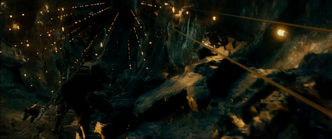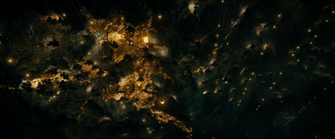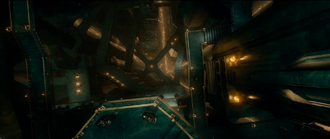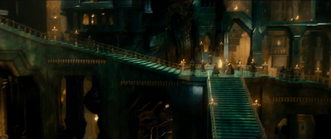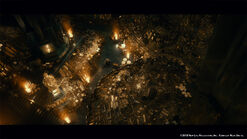Tags: Visual edit apiedit |
(→War of the Ring: Fixed another typo) Tags: Visual edit apiedit |
||
| (21 intermediate revisions by 16 users not shown) | |||
| Line 15: | Line 15: | ||
|languages= [[Westron]], [[Khuzdul]] |
|languages= [[Westron]], [[Khuzdul]] |
||
|lifespan=[[TA 1999]] - [[TA 2770]], [[TA 2941]] - [[Fourth Age]]<ref name=secondage>''[[The Lord of the Rings]]'', [[Appendix B]]: The Tale of Years (Chronology of the Westlands), "The Second Age"</ref> |
|lifespan=[[TA 1999]] - [[TA 2770]], [[TA 2941]] - [[Fourth Age]]<ref name=secondage>''[[The Lord of the Rings]]'', [[Appendix B]]: The Tale of Years (Chronology of the Westlands), "The Second Age"</ref> |
||
| + | }}For the latter half of the Third Age, the '''Lonely Mountain''' was the greatest kingdom in Middle-Earth. It was located in northeast of [[Rhovanion]], and was the source of the [[River Running]]. It was called '''Erebor''' in [[Sindarin]]. |
||
| − | }}The '''Lonely Mountain''', also known as Erebor, was the greatest dwarf kingdom in Middle-Earth. |
||
| − | |||
| − | [[Sindarin]], is a mountain northeast of [[Rhovanion]]. It was also the source of the [[River Running]]. |
||
==History== |
==History== |
||
| Line 44: | Line 42: | ||
=====Battle of Dale===== |
=====Battle of Dale===== |
||
| − | [[File:Erebor_gate.jpg|thumb|250px|The Gate of the Lonely Mountain, as portrayed in Peter Jackson's ''The |
+ | [[File:Erebor_gate.jpg|thumb|250px|The Gate of the Lonely Mountain, as portrayed in Peter Jackson's ''The Hobbit'' trilogy.]] |
The demise of Smaug was not to be the last of Lonely Mountain's many troubles. In [[TA 3019]] on the [[March 17|17th of March]], a horde of [[Easterling]] soldiers from Rhûn swarmed over the [[Redwater]] river, opening up a second front in the northern theater of the [[War of the Ring]]. The sheer force of the feared and renowned Easterlings crushed the Men of Dale and routed their forces, which had to rally back to the protection of the Lonely Mountain. |
The demise of Smaug was not to be the last of Lonely Mountain's many troubles. In [[TA 3019]] on the [[March 17|17th of March]], a horde of [[Easterling]] soldiers from Rhûn swarmed over the [[Redwater]] river, opening up a second front in the northern theater of the [[War of the Ring]]. The sheer force of the feared and renowned Easterlings crushed the Men of Dale and routed their forces, which had to rally back to the protection of the Lonely Mountain. |
||
| − | The Dwarves and Men fought a pitched [[Battle of Dale|battle]] against the invaders, eventually emerging victorious over their opponents. The impenetrable gates and walls of the Lonely Mountain, furnished and extensively worked with advanced, complex and intricate Dwarven stonework, defense planning and smith-work, easily withstood the siege equipment of the Easterlings. The Lonely Mountain itself was a key strong-point and gave its defenders great tactical leverage against the attackers, being able to shoot arrows and fling stones down below in reprisal. The many years invested in improving the Lonely Mountain's defenses had paid off, and the defenders outlasted the Easterlings in the siege. The Easterlings then withdrew, suffering disproportionate casualties because of their botched campaign and their difficulty in combating the Dwarven technology, weapons, armor and defenses. |
+ | The Dwarves and Men fought a pitched [[Battle of Dale|battle]] against the invaders, in which King Dain and The king of Dale at the time were killed, eventually emerging victorious over their opponents. The impenetrable gates and walls of the Lonely Mountain, furnished and extensively worked with advanced, complex and intricate Dwarven stonework, defense planning and smith-work, easily withstood the siege equipment of the Easterlings. The Lonely Mountain itself was a key strong-point and gave its defenders great tactical leverage against the attackers, being able to shoot arrows and fling stones down below in reprisal. The many years invested in improving the Lonely Mountain's defenses had paid off, and the defenders outlasted the Easterlings in the siege. The Easterlings then withdrew, suffering disproportionate casualties because of their botched campaign and their difficulty in combating the Dwarven technology, weapons, armor and defenses. |
====Fourth Age==== |
====Fourth Age==== |
||
| Line 54: | Line 52: | ||
The Lonely Mountain was a minor place for battle during The War of the Ring. The city took a small hit but it was rebuilt during the Fourth Age with the help of men and all of the Dwarves. With the restoration of the Kingdom under the Mountain the area became prosperous again. Dwarves and Men reforged their friendship. [[Dáin]] was killed during the [[War of the Ring]], and was succeeded by his son [[Thorin III Stonehelm]] who ruled well into the Fourth Age. During this time, Dwarves from the Lonely Mountain helped rebuild cities in [[Gondor]] and the [[fortress]] of [[Helm's Deep]], and some went to the newly established Dwarven realm of the [[Glittering Caves]] where [[Gimli]] was [[Lord of the Glittering Caves|lord]]. Late in the Fourth Age the Lonely Mountain was attacked by a large force of Orcs which was destroyed easily by the Dwarves. After this it is thought that the Lonely Mountain continued to flourish for many years after. |
The Lonely Mountain was a minor place for battle during The War of the Ring. The city took a small hit but it was rebuilt during the Fourth Age with the help of men and all of the Dwarves. With the restoration of the Kingdom under the Mountain the area became prosperous again. Dwarves and Men reforged their friendship. [[Dáin]] was killed during the [[War of the Ring]], and was succeeded by his son [[Thorin III Stonehelm]] who ruled well into the Fourth Age. During this time, Dwarves from the Lonely Mountain helped rebuild cities in [[Gondor]] and the [[fortress]] of [[Helm's Deep]], and some went to the newly established Dwarven realm of the [[Glittering Caves]] where [[Gimli]] was [[Lord of the Glittering Caves|lord]]. Late in the Fourth Age the Lonely Mountain was attacked by a large force of Orcs which was destroyed easily by the Dwarves. After this it is thought that the Lonely Mountain continued to flourish for many years after. |
||
| − | == Military of Erebor == |
+ | == Military Forces of Erebor == |
| − | Erebor had a strong well armored and equipped Dwarven army able to defeat even the toughest foes. The Army consisted of over 10,000 Dwarves. They had only Infantry and |
+ | Erebor had a strong well armored and equipped Dwarven army able to defeat even the toughest foes. The Army consisted of over 10,000 Dwarves of Erebor.. They had only Infantry, Artillery Machinery and Mounted Machinery as Balin stated while riding a war chariot " It's been a while since I rode on one of these things". Possibly the strongest Artillery in Middle-Earth as it is stated that a huge army of Easterlings tried to attack Erebor/Dale in the TA "but they were no match for Dwarven Machinery,weapons,armor,and defenses." |
| + | |||
| + | If counting all Dwarven forces the number would rise significantly as it is stated in the trilogy that the "Dwarves will defend their kin no matter what" |
||
==Portrayals in adaptations== |
==Portrayals in adaptations== |
||
===The Hobbit film trilogy=== |
===The Hobbit film trilogy=== |
||
| − | [[The Hobbit (films)|Peter Jackson's Hobbit trilogy]] (2012-2014) featured computer-generated shots of the Lonely Mountain, Dale, and other Dwarven cities. |
+ | [[The Hobbit (films)|Peter Jackson's Hobbit trilogy]] (2012-2014) featured computer-generated shots of the Lonely Mountain, Dale, and other Dwarven cities. |
| ⚫ | |||
| ⚫ | |||
| ⚫ | |||
| ⚫ | |||
==Translations around the World== |
==Translations around the World== |
||
| Line 67: | Line 71: | ||
!Translated name |
!Translated name |
||
|- |
|- |
||
| − | |Afrikaans |
+ | |Afrikaans |
|Eensame Berg |
|Eensame Berg |
||
|- |
|- |
||
|Arabic |
|Arabic |
||
| − | | |
+ | |الجبل الوحيد |
|- |
|- |
||
| − | |Armenian |
+ | |Armenian |
|միայնակ լեռնային |
|միայնակ լեռնային |
||
|- |
|- |
||
| Line 79: | Line 83: | ||
|Aдзінокая Гара |
|Aдзінокая Гара |
||
|- |
|- |
||
| − | |Bengali |
+ | |Bengali |
|লোনলি মাউন্টেন |
|লোনলি মাউন্টেন |
||
|- |
|- |
||
| − | |Bosnian |
+ | |Bosnian |
|Usamljena planina |
|Usamljena planina |
||
|- |
|- |
||
| Line 91: | Line 95: | ||
|孤山 |
|孤山 |
||
|- |
|- |
||
| − | |Catalan |
+ | |Catalan |
|Muntanya Solitària |
|Muntanya Solitària |
||
|- |
|- |
||
| − | |Croatian |
+ | |Croatian |
|Usamljena planina |
|Usamljena planina |
||
|- |
|- |
||
| Line 109: | Line 113: | ||
|Soleca Monto |
|Soleca Monto |
||
|- |
|- |
||
| − | |Estonian |
+ | |Estonian |
|Üksildane mägi |
|Üksildane mägi |
||
|- |
|- |
||
| Line 124: | Line 128: | ||
|Μοναχικό ορεινό |
|Μοναχικό ορεινό |
||
|- |
|- |
||
| − | |Gujarati |
+ | |Gujarati |
|લોન્લી માઉન્ટેન |
|લોન્લી માઉન્ટેન |
||
|- |
|- |
||
| Line 133: | Line 137: | ||
|孤独な山 |
|孤独な山 |
||
|- |
|- |
||
| − | |Galician |
+ | |Galician |
|Montaña Solitaria |
|Montaña Solitaria |
||
|- |
|- |
||
| − | |Georgian |
+ | |Georgian |
|განმარტოებული მთა |
|განმარტოებული მთა |
||
|- |
|- |
||
|Haitian Creole |
|Haitian Creole |
||
| − | |Mòn sèl |
+ | |Mòn sèl |
|- |
|- |
||
|Hindi |
|Hindi |
||
| Line 151: | Line 155: | ||
|Magányos Hegy |
|Magányos Hegy |
||
|- |
|- |
||
| − | |Icelandic |
+ | |Icelandic |
|Einmanna fjall |
|Einmanna fjall |
||
|- |
|- |
||
| − | |Indonesian |
+ | |Indonesian |
|Gunung sendiri ? |
|Gunung sendiri ? |
||
|- |
|- |
||
| Line 160: | Line 164: | ||
|Montagna Solitaria |
|Montagna Solitaria |
||
|- |
|- |
||
| − | |Kannada |
+ | |Kannada |
|ಲೋನ್ಲಿ ಮೌಂಟೇನ್ |
|ಲೋನ್ಲಿ ಮೌಂಟೇನ್ |
||
|- |
|- |
||
| Line 167: | Line 171: | ||
|- |
|- |
||
|Latin |
|Latin |
||
| − | |Montem Sola |
+ | |Montem Sola |
|- |
|- |
||
| − | |Latvian |
+ | |Latvian |
|Vientuļo kalnu |
|Vientuļo kalnu |
||
|- |
|- |
||
| − | |Lithuanian |
+ | |Lithuanian |
|Vienišas kalnas |
|Vienišas kalnas |
||
|- |
|- |
||
|Malay |
|Malay |
||
| − | | |
+ | |Gunung Sepi |
|- |
|- |
||
|Maltese |
|Maltese |
||
|Solitarju Muntanja ? |
|Solitarju Muntanja ? |
||
|- |
|- |
||
| − | |Nepalese |
+ | |Nepalese |
|एक्लो पहाड |
|एक्लो पहाड |
||
|- |
|- |
||
| Line 208: | Line 212: | ||
|ภูเขาโลนลี่ |
|ภูเขาโลนลี่ |
||
|- |
|- |
||
| − | |Slovenian |
+ | |Slovenian |
|Osamljena gora |
|Osamljena gora |
||
|- |
|- |
||
| − | |Slovak |
+ | |Slovak |
|Osamelý Horské |
|Osamelý Horské |
||
| + | |- |
||
| + | |Sinhalese |
||
| + | |හුදකලා ගිරිය |
||
|- |
|- |
||
|Swedish |
|Swedish |
||
|Ensam Berg |
|Ensam Berg |
||
|- |
|- |
||
| − | |Tajik |
+ | |Tajik |
|бекас Маунтин |
|бекас Маунтин |
||
|- |
|- |
||
| Line 229: | Line 236: | ||
|Yalnız dağ |
|Yalnız dağ |
||
|- |
|- |
||
| − | |Ukrainian |
+ | |Ukrainian |
|Cамотня Гора |
|Cамотня Гора |
||
|- |
|- |
||
| Line 235: | Line 242: | ||
|تنہا پہاڑ |
|تنہا پہاڑ |
||
|- |
|- |
||
| − | |Uzbek |
+ | |Uzbek |
| − | |Yolg'iz tog ' |
+ | |Yolg'iz tog ' |
|- |
|- |
||
| − | |Vietnamese |
+ | |Vietnamese |
|Núi Cô đơn ? |
|Núi Cô đơn ? |
||
|- |
|- |
||
|Yiddish |
|Yiddish |
||
| − | |עלנט |
+ | |עלנט באַרגGallery |
|} |
|} |
||
| − | |||
| − | ==Gallery== |
||
<gallery spacing="medium" columns="3" orientation="landscape"> |
<gallery spacing="medium" columns="3" orientation="landscape"> |
||
| Line 270: | Line 275: | ||
[[he:ארבור]] |
[[he:ארבור]] |
||
| ⚫ | |||
| ⚫ | |||
| ⚫ | |||
| ⚫ | |||
[[de:Einsamer Berg]] |
[[de:Einsamer Berg]] |
||
| Line 283: | Line 284: | ||
[[pt-br:Montanha Solitária]] |
[[pt-br:Montanha Solitária]] |
||
[[ru:Эребор]] |
[[ru:Эребор]] |
||
| + | [[Category:Mountains]] |
||
| + | [[Category:Dwarven Kingdoms]] |
||
| + | [[Category:Rhovanion]] |
||
| + | [[Category:Lonely Mountain| ]] |
||
Revision as of 19:37, 20 April 2016
For the latter half of the Third Age, the Lonely Mountain was the greatest kingdom in Middle-Earth. It was located in northeast of Rhovanion, and was the source of the River Running. It was called Erebor in Sindarin.
History
Years of the Trees and First Age : The Dwarves of Durin's Folk discovered the mineral wealth of the Lonely Mountain sometime after the awakening of the first Durin. A mining colony was soon set up and a road was laid out to connect the Dwarves to their great cities from the Iron Hills and as far west as their realms and possessions in the Blue Mountains.
Second and Third Ages
In the Beginning
The Dwarves may have lived and mined in the mountain during the Second Age, but it wasn't until the mid-Third Age that the colony had become a firmly established Kingdom of the Dwarves after the fall of the ancient Kingdom of Khazad-dûm due to the awakening of the Balrog later known as Durin's Bane in TA 1981. The survivors under Thráin I followed him to the Lonely Mountain and the colony became the ancestral home of the King under the Mountain. By TA 1999, it had become a Dwarven stronghold, where the Dwarves became a numerous and prosperous people. In this time, the Dwarves became very rich and amassed a large amount of gold and treasure which included the jewel known as the Arkenstone. Thrain I used the Arkenstone as a symbol of his rule, and his sons and grandsons under him who were to follow.
For two-hundred and eleven years the kingdom advanced, expanded, prospered, and endured until Thorin I abandoned it to join his kin in the Grey Mountains, and the Lonely Mountain was abandoned for three-hundred and eighty years. However, the Dwarves of the Grey Mountains began experiencing attacks by the dragons that still lived in those mountains, and became embroiled in a costly war against them, forcing the Dwarves to abandon the Grey Mountains in TA 2590. The Dwarves went their separate ways with Grór and his followers settling in the Iron Hills and Thrór and his followers settling in the Lonely Mountain.
Under Siege
While Thorin Oakenshield was out hunting one day in TA 2770, Smaug came from the mountains and invaded the Lonely Mountain, hoarding all its wealth for himself. Thráin II and several companions escaped by a secret door. For many years thereafter the Dwarves lived in exile in the Blue Mountains until, by a seemingly chance meeting, Gandalf the Grey met Thorin Oakenshield and together they planned to reclaim the mountain. This is told in detail in The Quest of Erebor and described by Tolkien's song, "Far Over the Misty Mountains Cold."
The Quest of Erebor
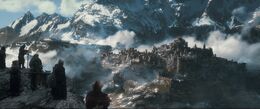
The Dwarves overlooking the Lonely Mountain
In TA 2941, Bilbo Baggins and Thorin's company traveled to the Lonely Mountain to regain the treasure Smaug had stolen. Set into the side of the mountain was a secret door, five feet high and wide enough for three to walk through abreast. Gandalf had managed to obtain the door's key, which fit a key hole which could be found only when the setting sun and the last moon of autumn (also known as Durin's Day) were in the sky would the light shine upon the keyhole. As told by Tolkien in The Hobbit, it took many days to find the door, and luckily for Thorin and Company they did not arrive on Durin's day so they had plenty of time to enter the mountain.
Smaug was eventually slain, shot out of the sky by a well-aimed arrow to his only weak spot by Bard the Bowman, a man of Laketown,he was a descendant of the king of Dale Girion, who later became king of the Men in the area known as Dale adjoining the Lonely Mountain. Thorin thus reclaimed the mountain, but the Elves of Mirkwood and Men of Lake-town claimed a part of the treasure, which Thorin refused to share. Dáin II Ironfoot came to the aid of his cousin Thorin, and the three Free Peoples almost did battle with one another, but then Orcs attacked and the Dwarves, elves, and men joined ranks together with the eagles against the Orcs, in what became known as the Battle of the Five Armies. During the battle Thorin was mortally injured, and the titles King under the Mountain and King of Durin's Folk passed to Dáin.
War of the Ring
Battle of Dale
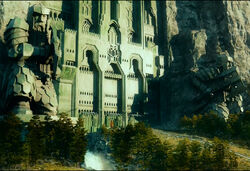
The Gate of the Lonely Mountain, as portrayed in Peter Jackson's The Hobbit trilogy.
The demise of Smaug was not to be the last of Lonely Mountain's many troubles. In TA 3019 on the 17th of March, a horde of Easterling soldiers from Rhûn swarmed over the Redwater river, opening up a second front in the northern theater of the War of the Ring. The sheer force of the feared and renowned Easterlings crushed the Men of Dale and routed their forces, which had to rally back to the protection of the Lonely Mountain.
The Dwarves and Men fought a pitched battle against the invaders, in which King Dain and The king of Dale at the time were killed, eventually emerging victorious over their opponents. The impenetrable gates and walls of the Lonely Mountain, furnished and extensively worked with advanced, complex and intricate Dwarven stonework, defense planning and smith-work, easily withstood the siege equipment of the Easterlings. The Lonely Mountain itself was a key strong-point and gave its defenders great tactical leverage against the attackers, being able to shoot arrows and fling stones down below in reprisal. The many years invested in improving the Lonely Mountain's defenses had paid off, and the defenders outlasted the Easterlings in the siege. The Easterlings then withdrew, suffering disproportionate casualties because of their botched campaign and their difficulty in combating the Dwarven technology, weapons, armor and defenses.
Fourth Age
The Lonely Mountain was a minor place for battle during The War of the Ring. The city took a small hit but it was rebuilt during the Fourth Age with the help of men and all of the Dwarves. With the restoration of the Kingdom under the Mountain the area became prosperous again. Dwarves and Men reforged their friendship. Dáin was killed during the War of the Ring, and was succeeded by his son Thorin III Stonehelm who ruled well into the Fourth Age. During this time, Dwarves from the Lonely Mountain helped rebuild cities in Gondor and the fortress of Helm's Deep, and some went to the newly established Dwarven realm of the Glittering Caves where Gimli was lord. Late in the Fourth Age the Lonely Mountain was attacked by a large force of Orcs which was destroyed easily by the Dwarves. After this it is thought that the Lonely Mountain continued to flourish for many years after.
Military Forces of Erebor
Erebor had a strong well armored and equipped Dwarven army able to defeat even the toughest foes. The Army consisted of over 10,000 Dwarves of Erebor.. They had only Infantry, Artillery Machinery and Mounted Machinery as Balin stated while riding a war chariot " It's been a while since I rode on one of these things". Possibly the strongest Artillery in Middle-Earth as it is stated that a huge army of Easterlings tried to attack Erebor/Dale in the TA "but they were no match for Dwarven Machinery,weapons,armor,and defenses."
If counting all Dwarven forces the number would rise significantly as it is stated in the trilogy that the "Dwarves will defend their kin no matter what"
Portrayals in adaptations
The Hobbit film trilogy
Peter Jackson's Hobbit trilogy (2012-2014) featured computer-generated shots of the Lonely Mountain, Dale, and other Dwarven cities.
Translations around the World
| Foreign Language | Translated name |
|---|---|
| Afrikaans | Eensame Berg |
| Arabic | الجبل الوحيد |
| Armenian | միայնակ լեռնային |
| Belarusian | Aдзінокая Гара |
| Bengali | লোনলি মাউন্টেন |
| Bosnian | Usamljena planina |
| Bulgarian | Самотна планина |
| Chinese (Hong Kong) | 孤山 |
| Catalan | Muntanya Solitària |
| Croatian | Usamljena planina |
| Czech | Osamělá Hora |
| Danish | Ensomme Bjerg |
| Dutch (Netherlands And Belgian) | Eenzame Berg |
| Esperanto | Soleca Monto |
| Estonian | Üksildane mägi |
| Finnish | Yksinäinen vuori |
| French | Mont Solitaire |
| German | Einsamer Berg |
| Greek | Μοναχικό ορεινό |
| Gujarati | લોન્લી માઉન્ટેન |
| Hebrew | הר בודד |
| Japanese | 孤独な山 |
| Galician | Montaña Solitaria |
| Georgian | განმარტოებული მთა |
| Haitian Creole | Mòn sèl |
| Hindi | लोनली पर्वत |
| Hmong | Roob kho siab |
| Hungarian | Magányos Hegy |
| Icelandic | Einmanna fjall |
| Indonesian | Gunung sendiri ? |
| Italian | Montagna Solitaria |
| Kannada | ಲೋನ್ಲಿ ಮೌಂಟೇನ್ |
| Korean | 외로운 산 ? |
| Latin | Montem Sola |
| Latvian | Vientuļo kalnu |
| Lithuanian | Vienišas kalnas |
| Malay | Gunung Sepi |
| Maltese | Solitarju Muntanja ? |
| Nepalese | एक्लो पहाड |
| Norwegian | Ensomfjellet |
| Persian | کوه تنهایی |
| Polish | Samotna Góra |
| Portuguese (Brazil and Portugal) | Montanha Solitária |
| Romanian | Muntele Singuratic |
| Russian | Одинокая Гора |
| Serbian | Усамљена планина ? (Cyrillic) Usamljena planina ? (Latinised) |
| Siamese (Thai) | ภูเขาโลนลี่ |
| Slovenian | Osamljena gora |
| Slovak | Osamelý Horské |
| Sinhalese | හුදකලා ගිරිය |
| Swedish | Ensam Berg |
| Tajik | бекас Маунтин |
| Tamil | லோன்லி மலை |
| Telugu | లోన్లీ మౌంటైన్ |
| Turkish | Yalnız dağ |
| Ukrainian | Cамотня Гора |
| Urdu | تنہا پہاڑ |
| Uzbek | Yolg'iz tog ' |
| Vietnamese | Núi Cô đơn ? |
| Yiddish | עלנט באַרגGallery |
References
- ↑ 1.0 1.1 The Lord of the Rings, Appendix B: The Tale of Years (Chronology of the Westlands), "The Second Age"

